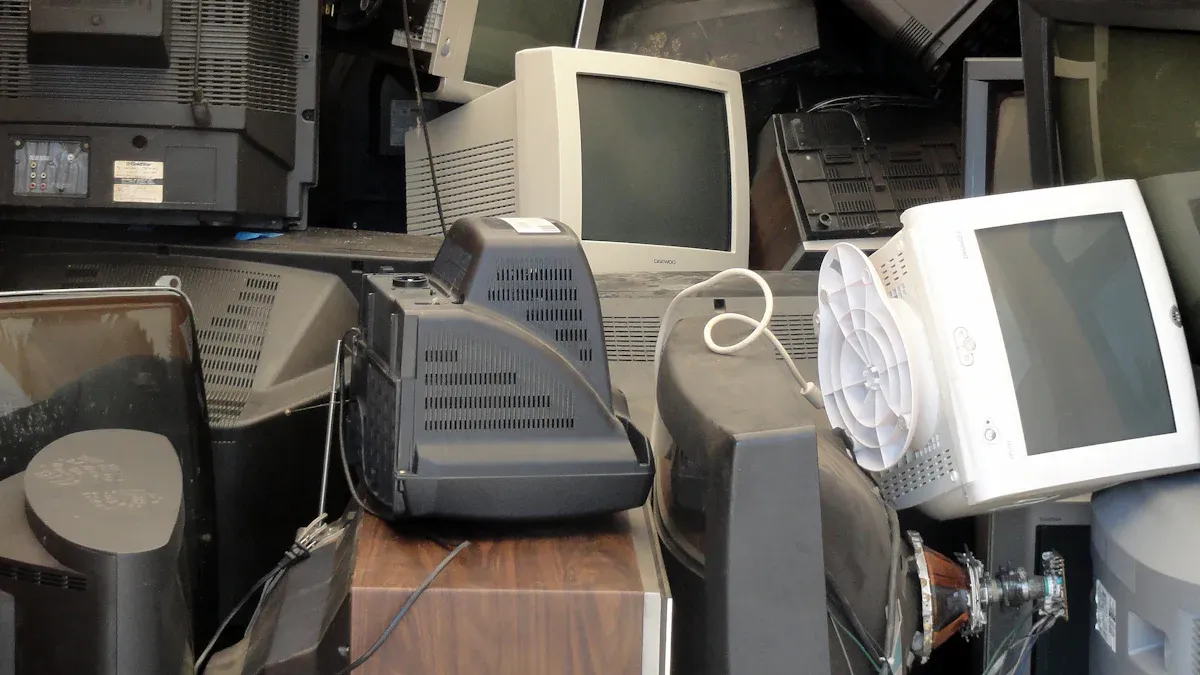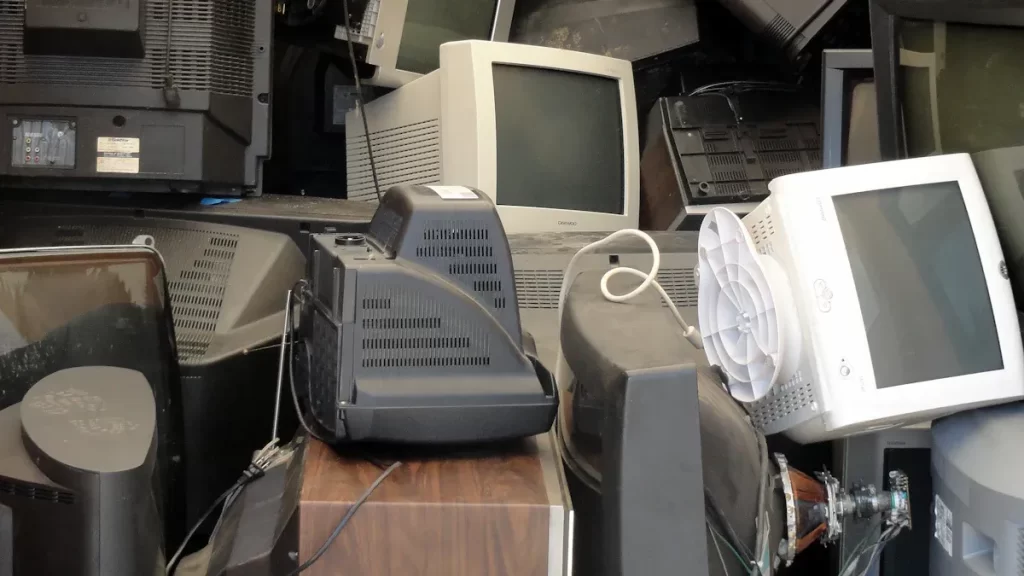
Electronic waste, or e-waste, refers to discarded electronic devices that often contain hazardous materials such as lead, mercury, or cadmium. Each year, more than 50 million metric tons of e-waste are generated globally, which averages about seven pounds per person. By 2030, this figure could rise to 75 million metric tons. Understanding what items can be considered e waste—such as phones, TVs, and laptops—can help you make informed decisions about disposing of them responsibly and reducing their environmental impact.
Key Takeaways
E-waste means old gadgets like phones, TVs, and computers. These items have dangerous materials, so proper disposal is important.
Recycling e-waste can save useful materials like gold and copper. It also helps cut down on pollution. Use approved recycling centers.
Throwing e-waste away can pollute soil, water, and air. This can hurt people, animals, and plants. Never toss electronics in the trash.
Try donating or fixing old devices instead of throwing them out. This helps others and creates less e-waste.
Find local recycling programs or drop-off spots for old electronics. Small efforts make the planet cleaner and healthier.
What items can be considered e waste?
Definition and characteristics of e-waste
E-waste means old or broken electronic devices and parts. These items often have harmful materials like lead, mercury, and cadmium. Such materials can hurt people and the environment. Unlike regular trash, e-waste needs special care because of its parts and the chance to reuse materials.
Key traits of e-waste include:
Characteristic | Description |
|---|---|
Collection and Processing | Gathering items, taking them apart, and sorting for reuse. |
Regulatory Compliance | Following strict rules for safe disposal and waste handling. |
Material Recovery Focus | Recovering valuable materials like gold and copper carefully. |
Technological Integration | Using advanced tools to process and recover materials better. |
These traits show why e-waste needs special treatment. Knowing this helps you see why proper disposal is so important.
Why electronic items are classified as e-waste
Electronic items become e-waste when they stop working or are replaced. Things like computers, phones, TVs, and fridges are examples. Parts like batteries, circuit boards, and cables are also e-waste because they are electronic.
Here’s how items are classified as e-waste:
They have harmful materials like lead, mercury, or cadmium.
They are thrown away when broken or outdated.
They include electronic parts like batteries and circuit boards.
They need special recycling to recover useful materials.
Knowing what counts as e-waste helps you dispose of devices safely and protect the environment.
Environmental and health risks associated with e-waste
E-waste can harm both nature and people. Dangerous materials like mercury and lead can pollute soil and water. Burning e-waste or dumping it improperly also harms the air.
E-waste grows by 4% every year, worsening environmental problems. In places without good recycling systems, the risks are even higher. Toxic exposure from e-waste can cause breathing issues, brain damage, and other health problems.
Tip: Recycling and disposing of e-waste properly can lower these risks and keep the planet safe.
By learning about e-waste dangers, you can help protect the earth by disposing of electronics responsibly.
Examples of e-waste
Common household electronics
Household electronics turn into e-waste when broken or replaced. Examples include TVs, fridges, and microwaves. These items often have harmful materials like mercury and lead. If not disposed of properly, they can harm the environment.
The growing pile of Waste Electrical and Electronic Equipment (WEEE) shows the rising e-waste problem. People expect electronics to last longer than they do. This leads to more discarded devices. Fixing these items instead of tossing them can lower e-waste and help the planet.
Tip: Try repairing old electronics before throwing them away.
Personal devices
Personal gadgets like phones, laptops, and tablets create a lot of e-waste. These devices have valuable materials like gold and copper. Recycling can recover these materials. But they also have toxic parts that need careful disposal.
When you get a new device, the old one often becomes e-waste. Recycling programs and take-back options help dispose of them safely. Recycling personal gadgets reduces landfill waste and saves resources.
Emoji Reminder: 📱💻 Recycling old gadgets helps the earth and saves materials!
Office equipment
Office items like printers, monitors, and fax machines are also e-waste. Many store sensitive data on hard drives. This data must be erased before disposal. Networking tools like routers and servers need special care due to metals and data risks.
Other office items, such as USBs and external drives, add to e-waste. Proper disposal stops these from harming the earth or leaking data. Recycling office electronics protects the planet and keeps data safe.
Note: Some recycling centers securely erase data from office electronics.
Miscellaneous items (e.g., batteries, cables, circuit boards)
E-waste isn’t just big items like TVs or laptops. Small things like batteries, cables, and circuit boards also add to the problem. These items might look safe, but they have harmful materials. If not recycled properly, they can damage the environment.
Batteries
Batteries are used in many devices like remotes and phones. They have dangerous chemicals like lead and lithium. If thrown in the trash, these chemicals can pollute soil and water.
Tip: Take old batteries to recycling centers or drop-off locations. Many stores accept them for safe disposal.
Cables and Wires
Cables and wires, like USB cords or chargers, are common e-waste. They have copper and plastic, which can be recycled. Instead of throwing them away, find programs that recycle electronic accessories.
Examples of recyclable cables:
HDMI cords
Ethernet wires
Charging cables
Recycling cables saves materials and keeps trash out of landfills.
Circuit Boards
Circuit boards are the “brains” of electronics. They have valuable metals like gold and silver. But they also contain harmful materials like mercury and lead. Throwing them away can release toxins into nature.
Emoji Reminder: ♻️ Recycling circuit boards helps the planet and recovers useful metals!
By recycling these small items, you help reduce e-waste. Always follow local rules for proper recycling to protect the earth.
Why proper disposal of e-waste is essential
Getting rid of e-waste the right way is very important. It helps protect nature and keeps people healthy. When you recycle electronics, you cut pollution, save resources, and help the planet. Let’s see why this matters.
Risks of improper disposal (e.g., pollution, health hazards)
Throwing away e-waste carelessly can cause big problems. Many electronics have harmful stuff like lead and mercury. If dumped in landfills or burned, these toxins can harm the earth and people.
Here’s how bad disposal affects us:
Soil Contamination: Dangerous metals from e-waste can poison the soil. This makes it unsafe for growing food.
Water Pollution: Chemicals from old electronics can mix with water. This hurts fish and makes drinking water unsafe.
Air Pollution: Burning e-waste releases toxic gases. These gases pollute the air and cause breathing problems.
Health Risks: Toxins from e-waste can lead to serious illnesses like cancer or brain damage.
Tip: Don’t throw electronics in the trash. Use recycling programs to stay safe.
Benefits of recycling e-waste (e.g., resource recovery, reducing landfill waste)
Recycling e-waste has many good effects. It helps save materials and keeps trash out of landfills.
Why recycling e-waste is helpful:
Resource Recovery: Electronics have valuable metals like gold and copper. Recycling gets these back and reduces mining.
Landfill Reduction: Recycling stops e-waste from piling up in landfills. This prevents harmful chemicals from leaking out.
Energy Savings: Using recycled materials takes less energy than making new ones.
Job Creation: Recycling programs create jobs for collecting and reusing old electronics.
Emoji Reminder: ♻️ Recycling helps save materials and keeps the earth clean!
Positive impact on the environment and economy
Recycling e-waste helps both the planet and the economy. It turns trash into useful materials and creates jobs.
How recycling helps:
Aspect | Impact |
|---|---|
Recycling turns e-waste into valuable resources, boosting the economy. | |
Cost Reduction | Better systems lower e-waste handling costs by up to 50%. |
Regulatory Frameworks | Strong laws encourage recycling and protect the environment. |
Governments and companies are working to improve e-waste recycling:
New rules make recycling easier and safer.
Laws push for less waste and fewer emissions.
Smart systems make recycling better for the planet and cheaper.
By recycling your old electronics, you help the earth and the economy. Even small actions, like recycling a phone, can make a big difference.
Note: Recycling e-waste helps create a cleaner, greener future for everyone.
How to dispose of e-waste responsibly
Getting rid of e-waste the right way helps the planet. It also saves resources. There are many ways to handle old electronics safely.
Local recycling programs and drop-off points
Many towns have recycling programs for e-waste. These programs help you get rid of electronics safely. Certified centers recycle items to recover useful materials and reduce harm.
Program Type | Events Held | Impact Level | Benefits to Nature |
|---|---|---|---|
Community Events | 350 | High | Reduces harmful waste runoff |
Certified Recycling Centers | 400 | High | Removes toxic materials |
Store Take-Back Programs | 150 | Medium | Prevents illegal dumping |
Donation Drives | 100 | Medium | Cuts need for new materials |
Curbside Pickup Services | 120 | High | Stops harmful waste runoff |
School Recycling Programs | 40 | Medium | Teaches kids to care for the environment |
Public Awareness Campaigns | 40 | Medium | Encourages reporting of illegal dumping |
Tip: Look online for local recycling events or drop-off spots near you.
Manufacturer take-back programs
Some companies now take back old electronics for recycling. These programs follow rules that make companies handle their product waste.
Some brands give money for returning old devices.
Apple’s program is a good example of recycling done right.
Required take-back programs work better than optional ones.
Joining these programs helps reduce e-waste and supports recycling efforts.
Donating or repurposing old electronics
Giving away or reusing old electronics is another great option. Many groups fix old devices and give them to people who need them.
MTM Health’s Green Team collected 700 pounds of e-waste in one event.
The Midwest Recycling Center (MRC) repairs and recycles electronics to cut waste.
Note: Make sure your device works or can be fixed before donating. Erase all personal data to stay safe.
Donating or reusing electronics helps others and protects the earth. It also keeps devices out of landfills.
E-waste means thrown-away electronics like gadgets and home appliances. These items have harmful materials that can hurt nature if not handled right.
Recycling and safe disposal help lower pollution and save useful metals. Simple actions, like donating old devices or using recycling programs, can make a big impact.
Reminder: Recycling electronics protects the earth and saves resources for the future. Look for safe disposal options near you today!
FAQ
What is e-waste?
E-waste means thrown-away electronics like phones, TVs, and laptops. These items have harmful materials like lead or mercury. Disposing of them properly stops pollution and saves useful resources.
Why is e-waste harmful?
E-waste has toxic materials that can harm soil, water, and air. If not handled right, it can hurt nature and people. Recycling helps lower these dangers and keeps the planet safe.
Tip: Take electronics to certified recycling centers to avoid harm.
Can you recycle all electronic devices?
Most electronics, like phones, computers, and batteries, can be recycled. Some items need special care. Check local recycling rules for details.
How can you reduce e-waste at home?
Fix broken devices, donate old gadgets, or recycle them. Buy fewer electronics and pick long-lasting ones to create less waste.
Emoji Reminder: 🌍 Recycling and reusing help protect the earth!
Where can you dispose of e-waste responsibly?
You can drop off e-waste at recycling centers, take-back programs, or events. Some stores also accept old electronics for safe recycling.
Note: Look online to find e-waste drop-off spots near you.
See Also
Latest Developments in GST and Customs for PCBA Products
Exploring Sub PCBA Uses in Consumer Electronics and More
Navigating ITAR Regulations for PCBA Production in 2025
Simplifying Electronic Assembly Outsourcing for Modern Businesses
Comparing Lead-Free and Lead-Based Processes in PCBA Manufacturing





